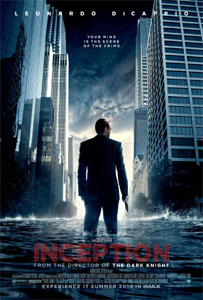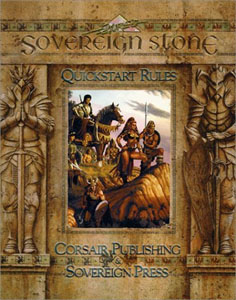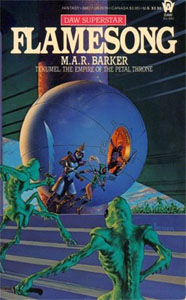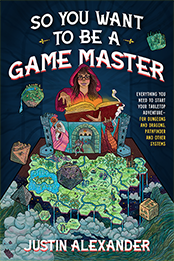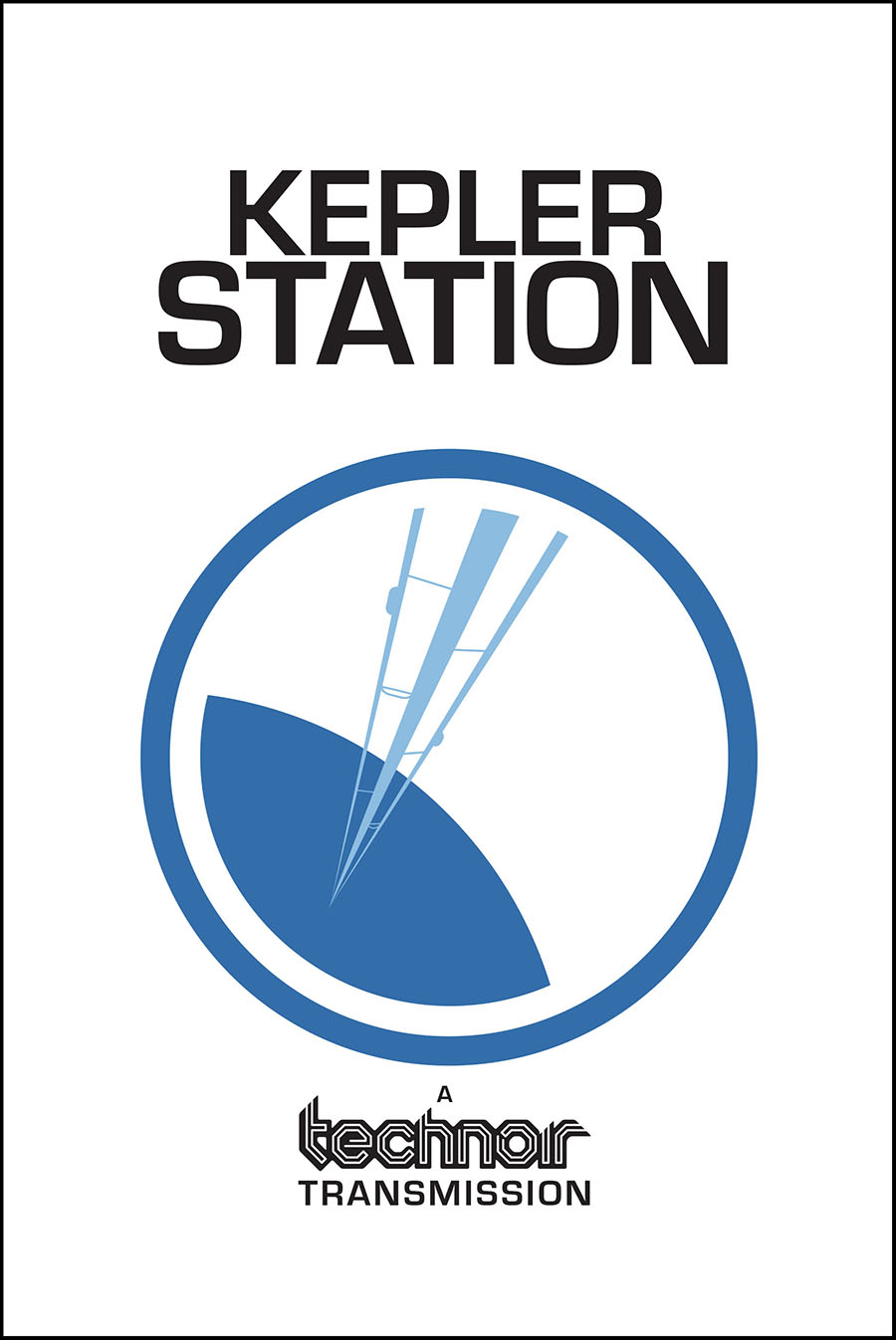Tagline: Heavy Ordnance is an irreverent little game with a strong set of mechanics and a quirky sense of humor. Best of all… it’s free!
“On this playground, dumb luck carries a gun…”
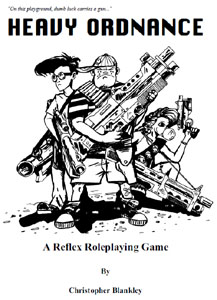 With the dawn of the Internet millions of creative souls who had never before been able to distribute their creations beyond a select group of friends suddenly found a cheap and inexpensive way of distributing them to millions. I think it can be safely said that the online RPG community remains one of the most vibrant creative communities around – due, in no small part, to the fact that RPGs have been on the ‘net far longer than most of the people reading this review have. I could wax into nostalgia at this point regarding long hours spent combing through FTP sites for fan-produced AD&D supplements, but I won’t.
With the dawn of the Internet millions of creative souls who had never before been able to distribute their creations beyond a select group of friends suddenly found a cheap and inexpensive way of distributing them to millions. I think it can be safely said that the online RPG community remains one of the most vibrant creative communities around – due, in no small part, to the fact that RPGs have been on the ‘net far longer than most of the people reading this review have. I could wax into nostalgia at this point regarding long hours spent combing through FTP sites for fan-produced AD&D supplements, but I won’t.
It comes as no small surprise that among the many fan-created RPG products which have found their way onto the ‘net, homebrewed systems should be among them. It has often been said that there is not a serious gamer alive who has not, at some point in his life, modified his favorite game or endeavored to create a brand new one. Previously these things were played by you and a few of your close friends (if you were lucky), and did little else. Now you can type them up and post ‘em – and many have done so.
It also comes as no small surprise, however, that a good 95% (if not more) of these systems are of more than questionable quality. Even if the engine is good, the setting usually isn’t. (Or vice versa.) On the other hand, there are exceptions.
FUDGE, of course, remains the pre-eminent example of how a good “freebie” system can make the transition into a “serious system”, being the first such system to be “picked up” by a publishing company and published in actual book form (by Grey Ghost Games). Designed by Steffan O’Sullivan with help from Usenet newsgroups, FUDGE was the original modular system – GMs are expected to swap in and out whatever components of the system they want to use and to modify it all to their heart’s content. Someday I’ll get around to giving FUDGE the review it deserves, but until then I’ll attempt to control my passion about this game.
But there are other games (including many which have not been picked up by “legitimate” publishers) on the ‘net which are worth a second look… perhaps even some play time. Heavy Ordnance is one of those.
SETTING
“Disclaimer: Heavy Ordnance is not real. It should not be treated as such. The people here in aren’t real, demons aren’t real, and the author in no fashion condones the use of firearms to solve conflicts with K-12 instructors. Of course, if they’re drooling acid and eating your best friend’s brains, come back and talk to me. We’ll see what I can do…”
You are a prepubescent teen. The meat loaf in the cafeteria has suffered a runaway nuclear reaction and the fallout is that anyone who has hit puberty has been possessed by demons whose meals consist of a single course: Human brains. Fortunately your school was built next door to the National Guard base and you managed to break in and load yourself down with some serious armaments. Naturally you know how to use all these things… you’ve played DOOM.
“Believe it or not, but there is the opportunity for some kind of plot in Heavy Ordnance. It’s not all blood and guns (yeah, sure, right, whatever…). You’ll have to do some work, but a game of Heavy Ordnance could be quite enriching. (chuckle)”
Heavy Ordnance, as you can tell, is an irreverent game. It’s setting isn’t designed to make sense, it isn’t designed for epic campaigns, and it isn’t designed for “serious roleplaying”. It’s designed to be fun. And it works. If you’ve read the comic strip Sluggy Freelance (and if you haven’t, you should) then you know exactly where this game is at. Now that I think about it, adding a psychotic bunny might be enough to make Heavy Ordnance a perfect game. But I digress…
The first two paragraphs in this section basically tell you everything there is to know (although there are several interesting points which I’m not going to mention because they’re of a spoiler nature). This is laid out in a couple of teaser paragraphs at the beginning, a relatively large section on the world background (a significant chunk of which is dedicated to a “wouldn’t it be neat if…?” series of adventure seeds), and an intro module — “Stupid is as Stupid Does” — wherein the PCs go on a combat mission to the junior high to see if there are any enclaves of resistance left there. (Actually “Stupid is as Stupid Does” is a sequel to the generic first adventure wherein the PCs play through the cafeteria blowing up and the first appearance of the demons, which is merely outlined for the GM.)
SYSTEM
Most systems for freebie games are one of three things: (1) Rip-offs; (2) Bad; or (3) Both. Those that fall into the first category aren’t exactly heinous offenders considering that a good 75% of all games have systems which are “ripped off” from other sources. Those that fall into the latter can usually be replaced easily enough with something else if the background makes it worthwhile.
Heavy Ordnance’s “Reflex System”, on the other hand, is generally quite good. Although it does have a handful of drawbacks and design flaws (which are noted below), it is peppered with good, original ideas.
The other nice thing is that after ever single rule (and I mean every rule) an informative and humorous example is given. Kudos.
CHARACTER CREATION
Character creation in Heavy Ordnance has always stuck in my memory for the following quote: “Due to the intensive study methods employed by the American school system, characters in Heavy Ordnance are amazingly skilled for their age. (You there, stop laughing, this is serious!)” It doesn’t really have much to do with the system itself, but it does (in the quirky, humorous style which is found throughout the game) explain the type of characters you’re going to end up with at the end of your character creation session.
The first thing that becomes obvious is that this is a dice pool system – your attributes and skills give you a number of dice which you roll (this is discussed in more detail below). One of the more interesting concepts in Heavy Ordnance, however, is the method by which this is handled: Attributes and skills are not quantified by a number of a dice; rather they are quantified by “pips” – a number between 1 and 150+. The number of pips you have then determines how many dice you get for that attribute or skill. A table is provided on your character sheet for easy reference, but it breaks down like this theoretically: For 10 pips you get 1d. To get additional dice you have to get n+10 additional pips, where n is the number of pips you had previously. Hence at (10 + 20 =) 30 pips you get a second die; at (30 + 30 =) 60 pips you get a third die; and so on.
This is nice. It allows for a dice pool system without the extreme coarseness of character advancement which is typical of a basic dice pool system. Additionally, it avoids the clunkiness of dice pool systems which have you assign different numbers of “points” to different elements in order to gain additional dice during character development. Plus, it is a tiered system so that it becomes more difficult to advance the more skilled or talented you get.
The next thing you have to determine is you age – which you simply pick. The game notes that if you’re older you can pick on younger kids; but that if you’re older you are that much closer to turning 14 and becoming a slavering, brain-eating demon. Part of me wishes that they had made this concrete (so that picking an older character would give you higher attributes and skills, for example); another part of me realizes that this would be ridiculous. Heavy Ordnance doesn’t exactly lend itself to campaign play, so the “threat” of turning into a demon in a year isn’t a threat at all.
You nine attributes – three Mental, three Physical, and three Averaged. Mental and Physical attributes are generated randomly by rolling 2d100 and dividing by two. The Averaged attributes are associated to one Mental and one Physical attribute – add those together and divide by two to arrive at your Averaged attribute.
Once again I’m of a mixed mind on this. As a general rule I really hate random character generation. On the other hand, for some reason it didn’t really bother me too much in this case. Possibly because of the throw-away, one-shot nature of Heavy Ordnance.
Skills are allocated, with each player getting 200 pips to distribute through them. There is a limited sub-skill system whereby the primary skill is rated based on the total number of pips (for example: Linguistics, 30 pips, 2d), while the pips are then distributed between the various sub-skills. For each set of 10 pips in a sub-skill you subtract one difficulty from any action attempted using that sub-skill (for example if you put all your Linguistic pips into Spanish and were attempting to speak to a Frenchman your difficulty might be 9; but speaking to a Spaniard your difficulty would only be 6). A relatively clever system, in my opinion, with many of the advantages of a skill-tree without the bureaucratic hassle.
Exceptional and Detrimental abilities bear a strong resemblance to the Advantages and Disadvantages of games like GURPS and Hero, although in this case the game designer has apparently decided to take a day off and leave things in the hands of the GM: The players come up with concepts and the GM assigns point values. The number of points a character has in Exceptional Abilities must equal the number of points he has in Detrimental abilities.
The most interesting section of Heavy Ordnance character creation are the personality quantifiers: Morality, Method, and Drive. Each of these is a dichotomous set of traits (Morality: Charitable-Selfish; Method: Conformist-Rebel; Drive: Pacifist-Militant). These are used in two ways: First, they are actually very useful in determining how a character will react to a particular situation – far moreso than an AD&D-style alignment system (they are greatly helped in this because they are not supposed to be a dogma of any kind). Second, they are used for determining when Hero Points (you may know these by the names of Luck Points and Fudge Points from other systems) at the discretion of the GM.
All in all this character creation system is clean, fast, and creates exactly the right kind of characters in exactly the right way for Heavy Ordnance. Plus it coins a couple of original ideas, and modifies old ones. Two definite thumbs up.
BASIC RESOLUTION MECHANIC
The biggest weakness of Heavy Ordnance is its resolution mechanic – largely because it’s showing its age. That’s kind of a weird thing to say about a five year old game, but Heavy Ordnance is a dice pool system which still suffers from the complete lack of statistical coherence which the early Storyteller system did – while even White Wolf has moved on and fixed many of those problems. Perhaps it isn’t entirely affair to hold a 1994 game to modern standards, but since I am writing this review today and not five years ago I don’t think I’m really being that unfair in noting the problem.
On the other hand, Heavy Ordnance does take advantage of some unique properties of an unfixed dice pool system which – if they had fixed it – they would not have been able to do. All in all, I’d have to say it ends up being a pretty fair trade-off when all is said and done. But then statistical coherence and accuracy has never been a high priority for me, particularly in games of this nature.
The basic resolution mechanic is this: The GM sets a target number. You roll a number of dice equal to your Attribute + Skill. Each die which is higher than the target number is a success, the others are failures. Each action takes one “round” of variable length (anywhere from a few seconds to hours to days, depending on the action) – this is primarily important for combat and extended actions.
First Complication: One die in every pool is the Fortune Die. If a roll of 10 comes up on the Fortune Die it counts as a success and you roll it again – if a success is rolled you add one to your total number of successes, raise the difficult by one, and roll again. You repeat this process until you roll a failure, at which point you stop rolling. If, on the other hand, a roll of 1 had come up on the Fortune Die you would roll it again – if a failure is rolled, you subtract one from your total number of successes, lower the difficulty, and roll again. You repeat this process until you roll a success (which does not count), at which point you stop rolling. Disregard any 1’s rolled while rerolling a 10 (although it still counts as a failure and you stop rolling).
Second Complication: Opposed actions are resolved by having both participants roll. The greater number of successes succeeds.
Third Complication: Extended actions (which take place over a long period of time) are resolved by the GM setting a specific number of necessary successes and having the player roll until they get that number of successes. Teams of characters may be able to work together to get the necessary number of successes, where appropriate.
Fourth Complication: To attempt multiple actions in a single round (or simultaneously at any time) you can split your dice pool. Only one Fortune Die is rolled, and the player decides where successes are added or subtracted.
I’ve always loved the elegance with which a dice pool system handles extended actions and multiple actions. Say what you want to against the statistical variance, you just can’t find a more intuitive way for handling those situations.
(Having said that, of course, I realize that it will now be a matter of minutes before someone does just that.)
COMBAT
Heavy Ordnance really shines in combat. It’s here where the system makes some serious claims to innovation, creating a nice, smooth system with a ton of tactical options.
Initiative. After declaring actions for the round, everyone assembles their dice pool (based on what action they’re taking). To determine initiative you then bid dice from your dice pool. For example, imagine that you’re squaring off against a demon. You bid one die to gain initiative. Then the demon bids two, so you bid three and get to go first. The trick, of course, is that the more dice you bid the lower your chance for ultimate success. When I first read this I was disappointed – it seemed like a bit of a gamist trick, with no correlation to reality. Then I realized that it was modeling the results of rushing an action. This is strengthened by a complementary system which allows you to raise difficulty to get additional dice. The dice you bid are placed in the “hero pool” (see below).
Overall I like this system: It connects skill to initiative, plus the bidding mechanic is an interesting idea. On the other hand, there are a couple of problems I have with it. First, the system isn’t entirely clear on whether or not you can raise your difficulty to get additional dice without actually bidding those dice on initiative – nor is it entirely clear (given the statistical nature of a dice pool system) what impact it would have. Second, while the system works very well for one-on-one and small group situations, as the number of combatants increases the system becomes crippled – if you’ve got, for example, ten combatants (a not unlikely figure when you total PCs and NPCs together) to determine clear initiative lines for everyone involved will exhaust everyone’s dice pools. The solution to this (undiscussed in the rulebook), I think, is to only worry about initiative between discrete groups in combat (hence you only worry about whether you or the demon you’re fighting goes first; not whether or not your friend who’s fighting a different demon is going before or after you). This only breaks down if a “chain forms” – you’re attacking a demon who’s attacking your friend, who’s attacking another demon, and so on (i.e., any situation where you can’t break the combat down into discrete groups).
Basic Combat System. Combat action resolution is identical to normal action resolution – roll your dice pool and count successes. The system is unclear about how you assign a target number for the roll, but apparently it’s left to the GM’s discretion based on the situation.
If you hit successfully you roll an additional d10 and compare it to a hit location chart (broken down into “Head”, “Torso”, “Abdomen”, “Left Arm”, “Right Arm”, “Left Leg”, and “Right Leg”). The most interesting part of this mechanic, though, is that additional successes allow you to “bump” your result – changing where on your target you hit by “one location”. The only confusing thing about this is that the language they use is imprecise, so you have to interpolate in order to conclude that “one location” refers not to the order on the hit location chart, but on the human body – thus you bump from “legs to abdomen” not “legs to arms” (which is the order they appear in on the hit location chart). I really like this system, which eliminates the need for a clunky “aimed shot” mechanic. The only problem is that you need to interpolate the damage system to realize that the hit location system is generalized for all types of combat, not just for the ranged combat section under which it is first described.
Finally damage is determined in one of four ways: (1) For ranged weapons you roll a die type which corresponds to the weapon you’re using (1d8 for 10mm pistol, 2d6 for a 12-guage, etc.) and then add your successes; (2) For Hand-to-Hand situations your damage equals your number of successes; (3) For Melee weapons your damage equals your number of successes plus a static damage modifier based on weapon type; and (4) Explosives have a die-rating like a ranged weapon and also a radius stat (e.g. a grenade has 4d6,2). This means that the grenade does 4d6 damage within two yards, and at every multiple of that radius (4 yards, 6 yards, etc.) the grenade will do one die less of damage (3d6, 2d6, etc.).
However, it isn’t quite as simple as you think. Each location has a number of hit points equal to the number of dice you have in the Well Being attribute – so if you have 2d Well Being, you have 2 hit points in each location. The type of damage in a location you take is based on the multiple of your hit points – for any amount less than your total number of hit points you’re Scratched; for any amount up to 2 times as many you have a Flesh Wound; 3 times as many and you’re Injured; 4 times, Seriously Injured; 7 times, Critically Injured; 10 times, Area Destroyed. For some reason the easy reference chart for this isn’t duplicated on the Character Sheet; it should have been. In any case, the system works like a charm – an intuitively clever handling of hit location damage. About the drawback is that the term “hit points” is misleading and unnecessary.
Ranged. Ranged Combat is the most basic combat resolution – declare action, form dice pool, determine initiative, roll, bump hit locations if necessary/wanted, and determine damage. Done deal. From a defensive standpoint, you cannot dodge a bullet – however, if you get initiative you can dodge the barrel of the gun with an Agility-Gymnatics roll, opposed to the shooter’s roll.
Automatic Fire is handled quite well. For a single target shot you determine how many rounds you want to/can fire in that round and then roll for the first shot. If that is successful, roll one die for every additional bullet that was fired against the same difficulty – your number of hits equals your first bullet plus the successes in the second group (so, essentially, 1 + your number of successes in the second roll). Hit location is determined by the first roll, bumping as appropriate.
Spraying an area is slightly different. You get a number of dice equal to the number of rounds you’re firing, and then subtract one for every 10-degrees of arc you’re attempting to cover. Roll these versus a difficult two higher than normal, divide successes evenly among the possible targets. Note that you aren’t using the dice from your dice pool, although these are still the dice you bid with for initiative (one die must remain at the end of initiative bidding). At first I thought this was unfair, then I realized that suppressive fire doesn’t take any time to set up (with aiming) – you just squeeze the trigger.
Explosive are also dealt with in this section, however, and they aren’t handled so well. The damage mechanic is simple and intuitive (as noted above), and a I like it a lot – the only problem is that the system doesn’t tell you how to determine how many yards away an explosive device is from a successful throw. I can think of several potential systems for resolving this, but this is a painful oversight.
Hand-to-Hand/Melee. Hand-to-Hand and Melee combat are only differentiated by the way damage is figured (dealt with above). They are both determined in the same way as basic ranged combat, with one catch – you can spend dice from your dice pool to raise the opponent’s difficulty on a one-to-one basis (spending one die, for example, would raise an opponent’s difficulty from 6 to 7). This is a really incredibly clever way of handling it: You want to go with an All-Out Defense? Just put all your dice into raising the other guy’s difficulty. All-Out Attack? All your dice into the attack. Plus any mix between those extremes.
Armor/Cover. Basically this simply absorbs damage (having a specific point rating depending on the type of armor/cover involved) – since a hit location system is used there’s no need for any frills here.
Hero Points. The dice you (and everyone else) bid at initiative are put into a “hero pool” for that round. By spending a hero point you can pick up that hero pool and add it to your roll for that round. Hero points are also the mechanism for character advancement – by spending one hero point you get 1d6 pips to spread around your skills and attributes.
MISCELLANEOUS STUFF
A few small points which I’ve discovered have been left over and don’t really fit in well anywhere else.
First, I am reviewing the PDF version of Heavy Ordnance. I don’t think that makes a whole lot of difference to this, but I thought I should mention it.
Second, this entire manual could have used a good editorial check. There are proliferous spelling and grammatical errors. I’m not one to get overly touchy about this sort of thing, but this was so over the top that it occasionally interfered seriously with my ability to enjoy the book.
Third, the cover art (by Lee Harrison) and general layout is superb. It captures the attitude and spirit of the game perfectly, drawing the reader into the product in a way few freebie RPGs have managed (and which many commercial ones completely fail to do). The interior art by Christopher Blankley (the author) takes the form of gag-line comic strips drawn from the source material. Their artistic quality is… uh… questionable, but they are quite clever – although their humor is several years out of date. (Barney jokes? Oh well, it was 1994.)
CONCLUSION
Heavy Ordnance is a really fun game. It seems to be possessed of much the same dynamic as Paranoia (although the PCs don’t die routinely and the humor is of an entirely different flavor) – you usually play it for one-shot fun, but occasionally a decent-sized campaign will tickle your funny bone as well. I think it would probably be ideal as a relaxing back-burner campaign setting you could step back to you while relaxing from your more intensive campaigns.
On top of that, the rule system (while possessed of editorial flaw and a couple of drawbacks) is fun, creative, and innovative. It’s a perfect match with the setting.
And hell, it’s free, so at the very least you should take a look for yourself.
Style: 4
Substance: 4
Author: Christopher Blankley
Company/Publisher: Reflex Systems
Cost: Free!
Page count: 50
ISBN: n/a
Originally Posted: 1999/07/26
“As a general rule I really hate random character generation…” Well, 1999 me is obviously not the me of today. Last year I actually spent a significant chunk of time trying to figure out how to randomly generate characters for Shadowrun as part of my aborted efforts to structure an open table for the system. The obvious disadvantage of a random system, of course, is that it doesn’t allow you to design or play the character that you want to play. And sometimes I really like to have that level of control over my PC. But I’ve also come to appreciate that random character generation (a) radically speeds up the process by which new players can be introduced to a system and (b) can serve as a really effective improv seed that you can use to create stuff you’d never dream of on your own. (Like, say, the OD&D character at my open table whose background included being cursed by a witch to have two hearts because he had broken hers; the strain of the second heart was the explanation for his incredibly low Constitution score.)
I always wanted to play Heavy Ordnance, but I think I missed my opportunity. This is a game that would have been a lot of fun when I was still a teenager. As a thirty-something? Not so much. If I did play it, the game would be a very different kind of fun — a nostalgic sort of fun as opposed to a purely gonzo escapist sort of fun.
I’m also, unfortunately, uncertain where you can obtain a copy of Heavy Ordnance these days. It used to be hosted on a number of different sites, but they appear to all be defunct. If anyone knows how to get in touch with Christopher Blankley, I would be more than happy to host his games here on the Alexandrian if they can’t find a home anywhere else.
For an explanation of where these reviews came from and why you can no longer find them at RPGNet, click here.

